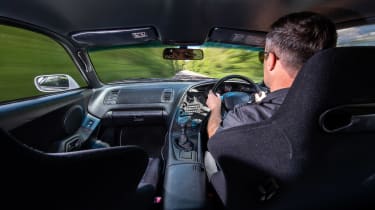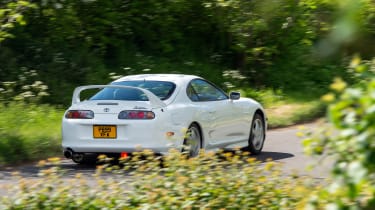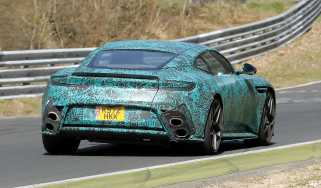Toyota Supra (A80) - review, history, prices and specs
It is part of the quintessential 90s Japanese performance car mix, but what’s the A80 Supra actually like?
It’s a legend!’ My new Polish friend is extremely excited. He’s already quoted engine and gearbox codes at me, and gazed longingly at the cloth Recaros. ‘Very rare,’ he says, with eyes-wide fervour. ‘So rare to see standard car,’ he adds, almost incredulous that I haven’t got a flip paint job, or an exhaust like a field artillery gun. Now he’s showing me pictures of his own Mk4 Toyota Supra on his phone, telling me how he bought the cheapest he could find back in Poland, a non-turbo model, or ‘SZ’ as my research has taught me, and then restored it, turbocharged it as well with one giant snail’s shell of a turbo. 700bhp. Boom, and probably plenty of whoosh.
‘Why the Supra though?’ I ask, unashamedly looking to gain material from this chance garage forecourt encounter. ‘When I was young, we had no supercars. But I had a VHS, a tape you know, with 1000bhp Supra, and it was the car we all dreamed of. “One day,” I said. “One day.” It was a legend.’
It’s a positivity shared with the cashier in that same garage, and the elderly couple with a hideous modern Nissan Pulsar, all of whom want to talk about the Supra; it was shared too by the young lad driving a Vauxhall Astra earlier – millimetres from the big white shark’s rear bumper, cameraphone blissfully blocking the majority of his forward vision. And there have been countless other examples during the past hour, from thumbs up to flashing headlamps to simply smiles. If you want people to notice you then don’t get a supercar, get a Supra.
None of this has anything to do with the Mk4 Supra’s first ‘life’, for they weren’t forming queues outside Toyota GB’s dealerships in the mid-’90s, craning necks for a peek at this GT flagship nestled between a Mk2 MR2 and, if you were really lucky, a Celica GT4. The Supra was gone by the end of 1996, emissions regulations in Europe the excuse given, just three years after it first arrived (although it would remain on sale in its homeland right through to 2002). No, the Supra was like that other revered ’90s Japanese performance icon, the Honda NSX: precious few with the necessary funds were inclined to walk past established rivals such as Porsche to spend big money on them when new, whatever the rhetoric surrounding them now.
The real reason the Supra is a legend today is due to Smokey Nagata, Jun, Best Motoring, Fast & Furious, Castrol TOMS, JGTC, SARD, Yellow Hat Super GT and, of course, Gran Turismo. Everyone’s driven a Supra in Gran Turismo, haven’t they, tuned to produce ludicrous amounts of horsepower? It’s also about a legendary engine, the 2JZ-GTE straight-six, that could make enormous power even with the internals untouched – just crank up the boost, much like the RB26 in Nissan’s rival Skyline GT‑R. While driving the new Supra for this issue, a young guy in a Fiesta ST came over to take a look. Impressed, his parting comment was still, ‘It needs a 2JZ in it.’ Legends never die…
All of which explains the hero worship, but what I want to experience is what the Supra is really like, away from the pixelated 1000bhp fantasy. To do that we’ve borrowed a 1996 Supra RZ, recently imported from Japan into the UK and lent to us by a very understanding and enthusiastic owner. It’s standard – highly unusual – and a manual – also highly unusual, sadly. Ideally, we would have driven a UK car, but there aren’t too many of them around, and most are automatics. It’s easy to spot a UK car by the bonnet vent that Japanese cars didn’t have. The active front spoiler was also standard in the UK, and there was a cooler for the rear diff to aid extended high-speed running. And there was more power – 326bhp versus the claimed 276bhp of the RZ we’re in today, although it’s probably more like a good 300bhp in reality, thanks to stronger turbos and larger fuel injectors.
The A80 made its global debut at the 1993 Chicago Auto Show, following a four-year development programme. As with so many Japanese cars, there was actually a whole range of models in the home market, unlike the sole derivative offered in the UK. The 225bhp non-turbo SZ was available with either a five-speed manual or four-speed auto, and that famous rear hoop wing was merely an option. Turbocharged models came in either RZ or luxury GZ trim, the latter with the four-speed auto only, but the former with the option of the six-speed Getrag ’box so sought after today. A T-bar open roof was also an option.
For its time the Supra was a highly sophisticated machine, and along with the GT-R and NSX a further example of the increased confidence, ambition and technological might of the big Japanese manufacturers at the beginning of the ’90s. Just contemplate for a moment its advanced specification: a 3-litre straight-six with sequential turbochargers, double wishbones all round with Bilstein dampers, an electrically powered front spoiler, traction control, the novelty of side airbags as well as the frontal ones, and an attention to weight saving that included an aluminium bonnet and carpeting made with hollow fibres. The UK buyer was expected to part with £37,500 for this in 1993, somewhere between the price of a Porsche 968 and a 993 Carrera, although in horsepower terms it easily eclipsed the latter. While the top speed was limited to 155mph, fully unleashed it was claimed nearly 180mph was achievable, and that, as I can clearly recall, was something of a sensation. Just over 600 were registered over the course of three years, the price having risen to £41,327 by the end.
It’s impossible to imagine a more ’90s fabric pattern than that which adorns the Recaros in this Supra – naive splashes of colour like the pattern on a pair of Bermuda shorts or some luminous T-shirt. The embrace of the seats is cosy, but without reach adjustment on the wheel the driving position is a bit cramped if I’m to avoid a bad case of the Stirling Moss (long-arm driving position, that is).
I’ll readily admit I’ve been looking forward to this moment. As someone whose early teenage years were spent being carted around in the passenger seat of a Mk2 MR2, not only does the switchgear and impeccably high quality black plastic seem so familiar, I also recall so damn clearly the absolute wonder of this beast. I’m talking about the Supra’s first life now, long before the grey imports began to arrive and the availability of YouTube videos and internet forums. Compared to a 236bhp 968 that really looked like a rehashed 944, or even next to a Ferrari 348 dare I say it, the all-new Supra was an absolute monster. Its curvaceous, smoothly styled form caught the mood of the time perfectly, and its brutish size and stats gave me the sort of excitable twitch I normally reserved for a chance encounter with a 911 Turbo or a Lotus Esprit. It helped that you never saw one, until that is you did, and then the impact was colossal. Power seemed to ooze from every meticulous panel gap like a superhero’s lifeblood.
Like so many older cars, the Supra doesn’t seem big at all today. What once had the gravitas of an Imperial Star Destroyer is now almost humble, its familiar five-spoke alloys just 17 inches in diameter. It’s the same inside, where it’s roomy but nothing like on the scale of a new BMW 8-series, although the manner in which the dashboard slopes away from you on the passenger side is so late-1980s I feel compelled to get some synthwave on the quaint hi-fi set-up pronto. The driver’s side isn’t exactly classy, but the logic behind it is obvious, with everything vaguely pointing at the driver, the dials deeply recessed. It’s a bit of a mess though, and I note how the top of the dash curves round to include the driver in everything to the exclusion of the passenger, the exact opposite of the new Supra, where the centre console is deliberately segregated from the driver. The view aft is unobstructed by the high-rise spoiler.
The ‘six’ fires with a whoosh, but boy is it quiet. One of the joys of cars from this era is that they never try too hard. I know there’s real power latent in that engine, even by today’s standards, but the Supra makes no attempt to impress with its opening gambit. It’s subdued too, just padding around town, and the Recaros suddenly seem a bit incongruous, the electrically adjustable leather chairs of a UK car much more in sync with the car’s character. The same goes for the white paint and the side skirts: a more subtle, darker colour would seem like a better fit. Renaissance Red was always my favourite…
There’s a pleasing heft to all the controls. Not the kind of weight that requires real muscle power, but enough that the character of the car forms clearly in your mind. At the time, journos criticised the A80 for being a bit aloof, for lacking that involvement so cherished in a driver’s car. I can sort of see where they were coming from, but once again, the passage of time makes us see a car such as the Supra through a totally different prism of expectation. Maybe the steering doesn’t communicate like the helm in a 993, but the weighty, organic assistance feels so much more genuine than what you’ll find in a modern car, while the gearshift is positive and precise. You really know you’re driving the Supra, and it demands a certain amount of finesse to drive well, certainly enough that the thought of apps and hands-free conversations seem a bit irrelevant.
Once warmed through, the temptation to let the 2JZ get down to work is too much, and I squeeze the throttle pedal to the stop from low revs. The sequential turbo set-up means that lag is reduced, and while it has nothing on the response of the B58 engine in the new car, neither is it so laggy as to be a hindrance to your cross-country pace. The straight-six is, of course, a noble engine layout, and the 2JZ is buttery smooth, building momentum seductively until the mid-range, where there’s the distinct impression of the batten being passed over. It then surges to the red line with fantastic conviction, accompanied by a wonderfully natural howl. I’m surprised by how quick it still feels, and we’re soon stomping across the countryside at a very respectable speed, the car chewing through gears, nose rising like the prow of a twin-engined speedboat. This is the stuff of Supra dreams, of keeping it pinned through each gear, the strobe effect of the Tokyo Expressway’s gantry lighting flickering in the peripheral vision and the speedo nudging towards the 200mph marker.
Of course, there’s no such activity today, but central England does throw up a lot of bends, and the A80 is pretty much what I was expecting. A little body roll and a certain sense of inertia tally with the ‘big Supra’ perception, blunting the ultimate agility, but it’s a car you pour into corners then smoothly accelerate out, building a rhythm and keeping the revs up for the engine’s best response when required. The whistle of the turbos and the growl of the six is a constant rising and falling companion, and I have to say, it all feels pretty good. It may not be in its element on narrow B-roads, but I’d love to do a long journey of fast, sweeping A-roads in it, and with the small rear seats behind and decent boot, it’s sort of practical too.
Reports of the time suggest that when it does get out of shape, it requires rapid and precise reactions to catch, and I can see that: under hard cornering you start to sense the weight of it – 1510kg is not especially heavy by modern standards, but in an era when cars were generally lighter, the Supra was a big beast of a car – and with a steering rack slower than we’re used to today and a more obviously turbocharged torque delivery, you have to stay on top of the situation.
It’s taken a little while to learn the subtleties of the Supra, but by the end of my time with it, driving it has become second nature. As I expected, it’s a very different car in standard guise from its modern public persona; a competent, logical, and in many ways still rather contemporary-feeling high-performance GT, surely a testament to the proficiency of a car that began its development in the late 1980s. But some things grow into an entity bigger than themselves, and the Supra is a case in point. It’s a difficult conundrum for Toyota, which wants desperately to leverage the goodwill that surrounds the Supra name, but inevitably is now marketing a very different sort of car, one that in many ways will appeal to a different audience.
Maybe in time that new car will develop its own legend, and sit comfortably within the historical hierarchy of great Japanese performance cars, but only time will tell us the answer to that one. In the meantime, I’m going to have one last blast of 2JZ power, just for research purposes, you understand. After all, it’s a legend, wherever on the planet you hail from.













